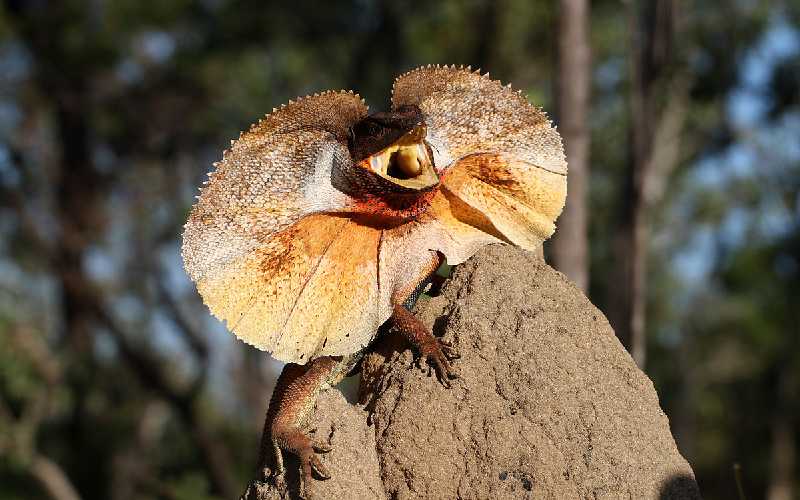Originally found in Northern Australia and Southern New Guinea, the frilled dragon (Chlamydosaurus kingii) is known for its impressive threats. It can be found in tropical woodland, amongst the humid environment and often high up in the treetops. They are what is known as arboreal lizards, meaning that they love climbing and moving between branches. The only time they would descend is when hunting for food, however, they quickly return to their natural dwelling.
What is a frilled dragon?
Typically, they are found with a mix of grey and brown colouring against their slender bodies and long tails. But it is their impressive and eccentric frills that give them their name. When feeling threatened or surprised, the frilled dragon will rear up and run quickly displaying its frills as a way to attack.
Their impressive nature doesn’t end with their large frills, but also their size. They are relatively large lizards, reaching almost up to 3 feet in length. Their size and frills make them the only member of the Chlamydosaurus family.
What is their diet?
Frilled dragons are capable of eating a balanced diet of meat and vegetation. Whilst they are omnivores and can eat both, their preference is most certainly geared towards protein. Especially when found in the wild, the frilled dragon typically seeks out other small lizards, invertebrates and very small mammals.
However, whilst in captivity, live insects work perfectly well. Brown crickets are the best option as they are extremely nutritious, allow your frilled dragon to chase and get some exercise without it being too difficult and widely available in most reptile shops.
Like with most reptiles that eat brown crickets, black crickets and locusts are a great alternative that will give similar nutrition and health benefits.
Don’t be afraid to give them a treat either, after all a happy frilled dragon is always great. Now and then, offer them a waxwork, calciworm, cockroach or mealworm. However, don’t feed them these too often – once or twice a week should be the maximum.
Always ensure there is a large (frilled dragon size) water bowl in the enclosure. At times they may drink from it, although typically they get their water intake from vegetation, however, it is great for them to bathe in to cool down.
Can I keep a Frilled Dragon as a pet?
There is nothing stopping individuals from owning the frilled dragon as a pet. However, they are incredibly difficult to get hold of. If you do manage to get hold of one there are a few things to know.
- Usually, they are docile and easy to take care of.
- They can feel threatened. When feeling scared or threatened the frilled dragon will replicate what it does in the wild. It will flare up its frills, stand on its hind legs and spit at you. Usually, this is a scare tactic and the frilled dragon won’t chase you. However, there have been cases where frilled dragons have nipped their owners or whipped their tails at.
That being said, if your frilled dragon has been bred in captivity and typically is used to being handled then it won’t mind. However, usually, they aren’t particularly fond of being held or touched.
If you’re thinking of getting more than one, that is perfectly fine. You’ll want to be careful of housing two males in the same enclosure as they will fight for territory. Males and females could breed if kept together, but that’s not definite. The unfortunate fact is that if they do breed, there will be lots of babies and therefore you’ll need a much larger enclosure.
If you enjoyed this article you might also like to read about Rankins Dragon


1 thought on “Introduction to the Frilled Dragon”